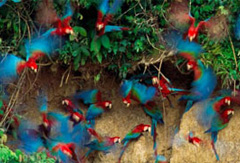|
|
MANU NATIONAL PARK |
home- |
|
|
|
Manu National Park, located in southeastern Peru, is one of the largest parks in South America. The area of the park encompasses parts of the Andean department of Cusco and the jungle department of Madre de Dios. Manu protects over 2 million hectares (4.5 million acres) of territory rich in flora and fauna species in a variety of habitats including high Andes, cloud forests, and lowland tropical rain forests. |
 |
UNESCO officially recognizes this natural paradise as a world heritage site. In 1977 they designated Manu as a World Biosphere Reserve because it contains the best existing example of biodiversity in protected areas of rain forest, as well as endemic areas of cloud forest. Humans have altered the majority of forests in the world. Fortunately, Manu has remained intact and untouched by civilization. Thus, we can observe a variety of animals in their natural habitats, including: Giant Otters (Pteronura brasiliensis), Black Caiman (Melanosuchus niger), the majestic Jaguar (Panthera onca), the strange Spectacled Bear (Tremarctos ornatus), the Tapir (Tapirus terrestris), the Ocelot (Felis pardalis), 13 species of primates, and an estimated one thousand species of birds including seven species of Macaws (Ara sp.). Manu also contains 10% of the world’s vascular plant species, including several species of figs and palms, as well as countless species of medicinal plants that scientists are currently cataloguing. A single hectare of forest in Manu can have up to 220 species of trees, while a hectare of temperate forest in Europe or North America may only have 20 tree species. Manu National Park may be the most biologically diverse and protected park on the planet. PROGRAMDAY 01: We leave Cusco early in the morning in our specialized overland vehicles. Approximately mid-morning we visit the interesting tombs of Ninamarca, commonly known as “Chullpas”. We continue to Paucartambo, a picturesque Spanish colonial town, and then to the Acjanacu pass, which marks the beginning of the Cultural Zone of Manu Biosphere Reserve. Here, a thick cloak of clouds provides perpetual humidity and makes an ideal habitat for epiphytic plants such as bromeliads. This varied and fascinating world is home of the Cock of the Rock, Spectacled Bear, Orchids, Tree Ferns (one of the oldest living plants), mosses and lichens. This cloud forest exists between 2,000 and 3,500 m.a.s.l. and at least 50% of the plant species found here are endemic to this region. Overnight at our “Orquídeas de San Pedro Lodge”. Day 02: Today we wake up very early to observe the Cock of the Rock (Rupicola peruviana), Peru’s national bird from a platform. The male birds are a vibrant reddish orange, and as many as several dozen come together for an exhibition of a mating ritual dance in a place called Lek. The males display their crest, showing off and posturing for the females. The females, fewer in number, watch to select the most suitable males. After breakfast we continue in our overland transport *1 down the narrow road between waterfalls and canyons toward the town of Pilcopata *2 and then to Atalaya Port. here we board our covered, outboard motor boat and head down the Alto Madre de Dios River for approximately 15 minutes toward our private reserve of “Erika” a comfortable 12 room lodge owned also by Manu Ecological Adventures where we will hike through the interesting trail system that this transitional area between high and low jungle offers. Overnight in the lodge. *1 Free Option: Descend with mountain bikes from our San Pedro Lodge (1700 m.a.s.l.) Cloud Forest to Pilcopata (700 m.a.s.l.) High Jungle. *2 Free Option: Here in Pilcopata town we will make the final settings for a 1 ½ river rafting (class I and II) trip down the Koshñipata River where we will have the opportunity for a dip and of course enjoy the spectacular view of the Koñeq Canyon. Continuing down the Alto Madre de Dios River to Erika Lodge. DAY 03: After breakfast we leave Erika Lodge and board our canoe for the four-hour ride down the Alto Madre de Dios River to Boca Manu’s airstrip. During our voyage we may see bird species typical of the river or forest edge such as: Black Skimmer, Pied Lapwing, Capped Heron, Jabiru Stork, and several species of kingfishers, swallows and flycatchers. Optional flight from Cusco to Boca-Manu; this means that some new members may join our group, the plane flies over the Andes to a narrow gravel landing strip in the jungle, the flight takes approximately 45 minutes. Boca Manu’s village is situated a short distance from the confluence of the Manu River with the Alto Madre de Dios River place where you can buy your last fresh supplies and cold drinks before setting off again in the canoe toward Boca Lodge where we will spend the night. Option to do a short nigh walk. *3 Free Option: New!!! Canopy tour: At Erika Lodge, our guests traverse from tree to tree and platform to platform using pulleys on horizontal traverse cables zip lines), as they sail through the treetops of the tropical rainforest canopy, and over the trails far below. Expert guides assist you in this exciting journey through the different layers of the virgin rain forests and explain what’s going on around you, from the time you leave the ground, until you rappel back down to the forest floor. DAY 04: Very early and after a ten minutes boat ride, we will arrive to a Parrot Lick “Collpa”, which is a wall of clay in the riverbanks, where many species of parrots such as the blue headed parrot, the white-eyed parakeet, the dusky-headed parrot the chestnut fronted macaw and others feed for mineral and salt supplements to their diet of seeds and fruits. After registering in the official tourist logbook at Limonal, the Park Rangers Headquarters and eating an early breakfast, we will continue travel up the Manu River for 4 hours approximately into the pristine heart of the reserve, we will leave the final traces of human habitation behind us. We arrive Salvador Lake, our base safari campsite (screened dining room, toilets / showers, solar panel system for some electricity and with radio communication available). Differences in wildlife abundance will be noted immediately we will begin to sight macaws, herons, kingfishers and cormorants frequently and improve our chances of encounters with capybaras, caiman, storks, ducks and other wildlife, you will often see animals sunning themselves on beaches, or foraging for food in the trees lining the riverbanks. This canoe ride gives us the opportunity to observe the immensity of the rainforest. We arrive early in the afternoon and have lunch before setting off on a jungle trail although at this time of day mammals and birds are not as active as in the early morning, we will concentrate on the forest itself and discuss general rain forest ecology, return to the campsite. DAY 05: We rise early in the morning, as the forest is awakened by the Red Howler monkey (Aloatta seniculus) declaring its territory. A morning walk before breakfast is a great way to catch wildlife in the pursuit of food, as the temperature is very pleasant at this time of day. We explore Salvador Lake by paddling quietly along on a catamaran, giving us the opportunity to observe unique species of birds, monkeys, caimans and with luck the Giant Otter (Pteronura brasiliensis). This endangered species can be seen swimming, fishing, eating and playing. After we enjoy lunch, we cross the river to walk an 8-km trail to another oxbow lake called Otorongo. This forest, which is estimated to be 200 to 300 years old and includes truly huge Ceiba trees and Strangler figs, and it is home to several mammals that are occasionally encountered: Saddleback tamarins, Squirrel, Spider and Brown Capuchin Monkeys, the Collared and the white lipped peccaries. At the lake a strategically located observation tower rises 15 meters above the lake and the jungle floor, from the top you not only get spectacular view of the lake and the surrounding forest but also excellent opportunities to observe birds from the canopy, this also gives us more chances to observe wildlife including the Giant Otter. Back at Salvador Lake, late in the afternoon we will use the catamaran and with the help of flashlights we can observe the black caimans rise from the depths of the lake and begin their search for prey. Return to the safari campsite. DAY 06: Once again we wake up early, enjoy walking around Salvador Lake and then pack up and slowly go down stream the interesting Manu River. We arrive at 3pm. approximately to the Valley’s a Island that belongs to a Native family and it’s possible to do a short walk through the forest to observe American bullfrogs, horned frogs, tree frogs and an incredible variety of colorful insects. We continue to Boca Manu’s Village, situated a short distance from the confluence of the Manu and Alto Madre de Dios rivers. From here we descend the Madre de Dios River arriving Juan de Dios Reserve and spend one more night at the Lodge in this magical Amazon jungle. Possibility to do a short night walk DAY 07: Around mid morning or before we board our canoe to return to the airstrip at Boca Manu. At this point, those who are returning to Cusco by plane will catch their flight. This optional flight from Boca Manu to Cusco offers spectacular views of the surrounding jungle and the area’s meandering rivers. The others continue up the Alto Madre de Dios River to camp on an appropriate beach in the Cultural Zone and enjoy the sites and sounds of the jungle for one last night. DAY 08: Waking up very early, we continue the trip by boat to Atalaya, where the bus will be waiting for us and drive back up and out of Manu, arriving in Cusco very late this night or the next early morning. END OF OUR SERVICES. IMPORTANT: In order to meet with group and guide, receive last recommendations and answer questions; briefing one day prior to departure at 7:00pm. at the agency. AIR CHARTER ALTERNATIVE
Important: We ask our clients taking flights not to exceed 10kgr. of luggage per person. SERVICES INCLUDED: Own ground transportation (overland buses and 4WD vehicles), own boat transportation (covered motor boats), Specialized and bilingual guides, 01 night in San Pedro open air lodge, 01 night in Erika Lodge, two-person tents, sleeping mattress, meals, first aid Kit including anti-ophidian shots) air charters (optional - maximum 10kgr. of luggage per person), paperwork and payment for Park permits, radio communication equipment in all lodges and campsites, Satellite telephone for emergencies and as additional service we offer safety box for values and storage for luggage in Cusco’s main office. THINGS YOU SHOULD BRING ALONG ON A TRIP TO MANU
|
www.peruvian-tours.com
PERU TOURS - MANU






